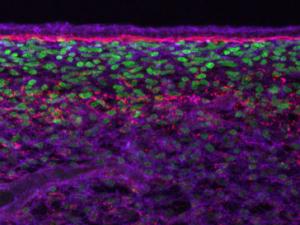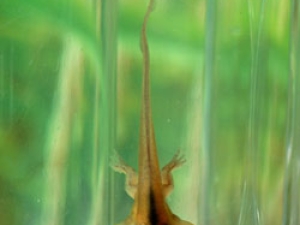

Research Bio
Richard Harland is a Professor of Genetics, Genomics, and Development; C.H. Li Distinguished Professor. The objective of his lab's work is to understand early vertebrate development at the molecular level. They study this problem in both the amphibian Xenopus, and in the mouse. Xenopus embryos are large and easily manipulated, so that the function of various macromolecules, such as RNA and protein, can be assayed by microinjection into living embryos. Functional assays in Xenopus can then be complemented by genetic knockouts in the mouse, to gain fuller understanding of the normal requirements for gene action in the developing embryo.
Current Projects
Axis formation, induction and patterning of the Neural Plate: The dorsal-ventral organization of the gastrula arises from a series of symmetry breaking steps, including the activation of early Wnt/beta catenin signaling, which synergizes with Nodal/Smad2 signaling to generate Spemann’s Organizer. Where Smad2 and beta-catenin signals overlap, the Organizer genes are expressed, and several of these are BMP antagonists, which prevent ventral BMP signals from inducing epidermis and ventral mesoderm, and allow, by default, the formation of the nervous system and dorsal mesoderm. At the same time the nervous system becomes patterned in the anterior posterior axis to form brain and spinal cord, with the default fate being brain, and spinal cord being induced by a combination of Fibroblast Growth Factor and a re-use of Wnt/beta catenin signaling (1).
To identify new signaling mechanisms, we developed methods to screen libraries of mRNAs to identify potent bioactivities, such as molecules that dorsalize the embryo (2). We then use explants to study how these signals determine the state of tissues at different times- when and how do these tissues become specified to form epidermis and nervous system, for example, in response to these signals; we also determine the biochemical mechanism for the activity. Noggin is one such molecule, which binds tightly to the BMPs and prevents them from signaling (3).
Shape changes in development: In addition to the molecules that determine cell fates, we are also interested in the cellular mechanisms that enable embryonic tissues to form the shape and organization of the tadpole. We showed that the Planar Cell Polarity pathway, originally studied in Drosophila, is also used in the frog gastrula, when the simple organization of the cleaving embryo rearranges to form the three germ layers of ectoderm, mesoderm and endoderm (4). This pathway continues to operate to elongate the tadpole, and along with the rolling up of the neural plate (5), is an important part of extending and closing the neural tube.
Genetics and Genomics of Xenopus: While Xenopus laevis, the South African Clawed frog, remains an ideal model to combine experimental manipulations of tissues, because of the large size of the embryo, and tolerance to injections and microsurgery, we have complemented this work with the use of the Western Clawed Frog, Xenopus tropicalis, which has a simpler, diploid genome, smaller size and more rapid development, all of which enable us to raise frogs quickly to exploit manipulations of the genes and genomes, in both forward and reverse genetic screens (6-8).
Both X. laevis and X. tropicalis are well suited to genome-wide approaches, and because of the large size of the embryo, we can isolate sufficient RNAs or proteins from just a few embryos for systems-level analysis. To facilitate this approach, we have collaborated with our colleague Dan Rokhsar and others to sequence and assemble the genome of X. tropicalis (9), and are completing the assembly of the X. laevis genome; we are continuing this approach with other frogs, so that we can contribute well-annotated and complete genomes for work with different frogs. We have used these assembled genomes to study the contribution of individual splicing factors to the organized maturation of messenger RNAs (10), and in other current projects, are using the assembled genomes to study the activation of gene expression by Wnt/beta catenin signaling during formation of the spinal cord and neural crest (11).
BMP antagonists in Mouse Development: To understand the role of BMP signaling and its attenuation in mammalian development, we have made mutants in BMP antagonists in the mouse. BMP signaling is used in many contexts, and the potent activity must be blocked in many developmental events to permit normal development (12). We have recently been most interested in the activity of overlapping BMP antagonists in development of the axial skeleton, where BMP signaling must first be prevented to allow formation of the skeletal precursors, and then permitted to permit the differentiation of these precursors (13).
BMP signaling must also be attenuated in the formation of the gut, where excess BMP signaling eliminated cells that control the smooth muscle activity and in a separate process prevents proper maturation of the stem cells of the intestinal crypts.
See faculty web page for selected publications and Google Scholar for a comprehensive list of publications.
Research Expertise and Interest
molecular biology, early vertebrate development, Xenopus, embryo development
In the News
London’s Royal Society elects four from Berkeley
Making chicken feathers
Lab frog DNA shows what happens when genomes collide
Scientists report first genome sequence of frog
The African clawed frog, Xenopus, has helped scientists understand how embryos develop and the many chemical reactions going on inside dividing cells. Now, scientists report the first draft genome sequence of Xenopus, setting the stage for a more complete genetic analysis of this popular frog.
Nine UC Berkeley faculty members elected to American Academy of Arts & Sciences
Nine UC Berkeley faculty members have been elected to the American Academy of Arts and Sciences, bringing to 234 the total number of faculty now members of one of the nation's oldest and most prestigious honorary societies.




